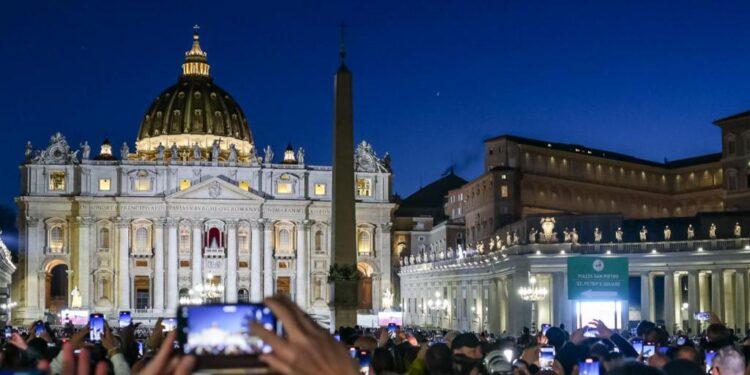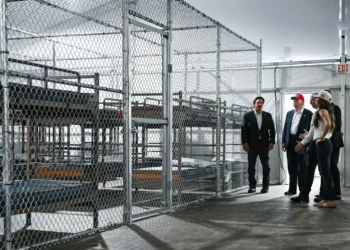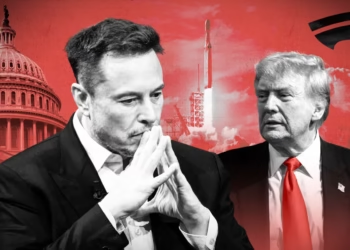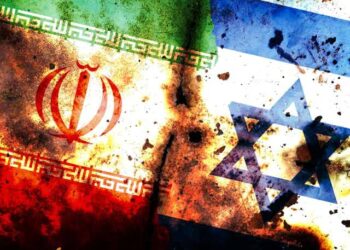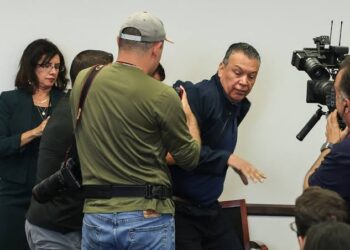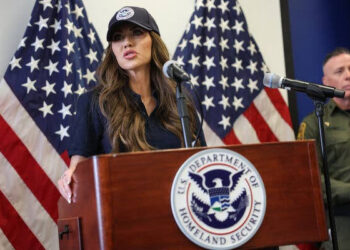The world is holding its breath as the cardinals gather for the 2025 conclave, awaiting the election of a new pope. On the first day, the cardinals met in the Sistine Chapel, and after a series of votes, black smoke rose from the chimney, indicating that no decision was reached.

The conclave live updates are providing real-time information on the proceedings. As the cardinals return for day two, the anticipation continues to build. The process is secretive and isolated, with the cardinals having taken oaths of secrecy.
Key Takeaways
- The 2025 conclave has begun with the cardinals gathering in the Sistine Chapel.
- Black smoke was emitted, signaling that no new pope was elected on the first day.
- The cardinals will continue their deliberations on the second day.
- The conclave is a secretive process with the cardinals isolated from the outside world.
- The world is eagerly awaiting the election of a new pope in 2025.
The First Day Results: Black Smoke Rises from the Sistine Chapel
The conclave’s first day concluded with black smoke, signaling no new pope was elected. This outcome was anticipated by many, given the complexity of the election process.
Wednesday Evening’s Vote Outcome
The cardinals participated in a series of votes on Wednesday, with the process lasting around three hours. The black smoke that emerged from the Sistine Chapel’s chimney indicated that no candidate achieved the required majority.
Three-Hour Deliberation Process
The deliberation process involved multiple rounds of voting, with cardinals engaging in prayer and reflection between ballots. This meticulous process is a hallmark of the conclave.
Crowd Reaction in St. Peter’s Square
Around 45,000 people gathered in St. Peter’s Square, awaiting the announcement. The crowd’s reaction to the black smoke was mixed, with some expressing disappointment and others showing understanding of the process. Thousands had gathered, all united in their anticipation of conclave news.
The crowd’s wait, which lasted several hours, was a testament to the global interest in the pope candidates and the direction of the Catholic Church. As vatican news today continues to unfold, the world watches with bated breath.
Understanding the Vatican Conclave Process for Electing a New Pope
The process of electing a new Pope, known as the Vatican Conclave, is steeped in tradition and secrecy. It involves a complex series of rituals and voting processes that are designed to ensure the integrity and solemnity of the occasion.
At the heart of the conclave is the secret ballot system, where cardinals cast their votes in a highly controlled and isolated environment. This system is designed to prevent external influence and ensure that the cardinals can make their decisions freely.
The Secret Ballot System
The secret ballot system is a cornerstone of the conclave process. Cardinals write the name of their chosen candidate on a ballot paper, which is then collected and counted. The process is repeated multiple times until a candidate achieves the required majority.
Required Two-Thirds Majority
To be elected, a candidate must receive a two-thirds majority of the votes cast. This requirement ensures that the new Pope has broad support among the cardinals. The voting process continues until this threshold is met.
Daily Voting Schedule and Procedures
The cardinals follow a strict daily schedule, which includes Mass, prayer, and multiple rounds of voting. The day begins early, with the cardinals attending Mass before retiring to the Sistine Chapel for their deliberations.
| Time | Activity |
|---|---|
| Morning | Mass and Prayer |
| Afternoon | Voting Sessions |
| Evening | Deliberations and Voting |
As the cardinals retired overnight, they will have breakfast and attend Mass this morning before returning to their deliberations. The senior cardinal, Giovanni Battista Re, prayed for the cardinals to be enlightened to choose “the Pope our time needs” during the mass in St. Peter’s Basilica on Wednesday morning.
“The Pope is elected by the cardinals in a conclave, a process that is both ancient and solemn.”
Vatican Insider
The conclave process is a remarkable display of faith, tradition, and the Catholic Church’s ability to adapt while maintaining its core values.
Vatican Conclave Cardinals Pope Francis New Pope2025 Sistine Chapel Overview
With the conclave underway, the attention is on the 133 cardinals who will decide the future of the Catholic Church. These cardinals, representing diverse backgrounds and geographic locations, are tasked with electing the next Pope.

The 133 Cardinals Participating in the Election
The cardinals participating in the conclave are a diverse group, with representatives from various parts of the world. Cardinal Pietro Parolin and Cardinal Luis Antonio Tagle have been among the favourites to succeed Pope Francis. The cardinals’ diverse backgrounds and experiences will play a crucial role in the election process.
Cardinal Demographics and Geographic Representation
The geographic representation of the cardinals is significant, with electors from Africa, Asia, Europe, and the Americas. This diversity brings different perspectives to the conclave, influencing the election of the next Pope.
Pope Francis’s Influence on Cardinal Selection
Pope Francis’s influence on the cardinal selection process has shaped the demographics of the electors. His emphasis on certain qualities in cardinals has contributed to the diversity seen among the 133 cardinals participating in the conclave.
The Sistine Chapel, with its iconic artwork and historic significance, serves as the backdrop for the conclave. The cardinals’ deliberations will take place within its walls, adding to the chapel’s rich history.
Communication Restrictions During the Papal Conclave
The papal conclave is a process shrouded in mystery, with strict rules governing the cardinals’ interactions with the outside world. To ensure the integrity of the election process, the cardinals are subject to rigorous communication restrictions.
Complete Isolation from Outside World
During the conclave, the cardinals are isolated from the outside world, with no access to external media or communication. They are required to hand in their phones and other communication devices, and are sworn to secrecy. This complete isolation is designed to prevent any external influence or bias.
Security Measures to Ensure Secrecy
The Vatican takes extensive security measures to maintain the secrecy of the conclave. Mobile phone towers are shut down in the vicinity of the Sistine Chapel to prevent any external communication. The cardinals are also subject to regular checks to ensure compliance with the rules.
Historical Reasons for Strict Protocols
The strict protocols governing the conclave have their roots in history. The Vatican security measures are designed to prevent any repetition of past controversies or interference. By maintaining secrecy, the cardinals can focus on electing the next pope without external influence.
The papal conclave rules are in place to ensure a smooth and transparent election process. By understanding these rules, we can appreciate the significance of the conclave and the importance of maintaining its secrecy.
Inside the Sistine Chapel: The Sacred Voting Location
Within the hallowed walls of the Sistine Chapel, the College of Cardinals embarks on the solemn duty of selecting a new Pope. The Sistine Chapel, a masterpiece of Renaissance art, is not only a sacred site but also a symbol of the Catholic Church’s rich history and spiritual heritage.
Physical Setup for Cardinal Deliberations
The physical setup of the Sistine Chapel is designed to facilitate the cardinal deliberations. The cardinals take oaths on the Altar of the Sistine Chapel, promising to follow the rules of the conclave. The chapel is arranged to ensure the secrecy and integrity of the voting process.

The Sistine Chapel Chimney’s Significance
The chimney of the Sistine Chapel plays a crucial role in signaling the outcome of the votes. As the ballots are burned, the color of the smoke indicates whether a new Pope has been elected. Black smoke signifies that no candidate has achieved the required majority, while white smoke announces the successful election of a new Pope.
Michelangelo’s Artwork as Backdrop to History
As the cardinals proceed with their sacred duty, they are surrounded by Michelangelo’s breathtaking frescoes, including the famous Last Judgment. This iconic artwork serves as a poignant reminder of the weighty responsibility shouldered by the cardinals. As one observer noted, “Standing before Michelangelo’s famous vision of heaven and hell, the cardinals swore to carry out the solemn duty of selecting a new Pope.”
The Sistine Chapel’s stunning artwork, including Michelangelo’s ceiling, provides a breathtaking backdrop to the conclave proceedings. The intricate details and vivid imagery of the frescoes underscore the spiritual and artistic significance of this historic location.
The Smoke Signal System: Black Smoke vs. White Smoke
The anticipation builds as the smoke rises from the Sistine Chapel, with black smoke indicating an unsuccessful vote and white smoke signaling the election of a new pope. This distinctive tradition is a crucial part of the papal conclave process.
Chemical Compounds Used for Different Smoke Colors
The color of the smoke is determined by the chemical compounds added to the burning ballots. To produce black smoke, a mixture containing carbon or other darkening agents is used, while white smoke is achieved by adding chemicals that produce a cleaner burn, resulting in a clearer signal.
Historical Evolution of the Tradition
The smoke signal system has a long history, dating back to the 19th century. It was introduced to provide a clear and immediate indication of the election outcome to the public gathered in St. Peter’s Square.
How Ballots Are Burned After Voting
After each round of voting, the ballots are burned in the Sistine Chapel’s stove. The smoke produced is then released through the chimney, visible to the crowd outside. The careful control of the smoke color ensures that the signal is clear and unambiguous, conveying the outcome of the election to the waiting world.
When a pope is chosen, white smoke will emerge, signaling the successful conclusion of the conclave. This moment is eagerly awaited by Catholics worldwide, marking the beginning of a new era in the Catholic Church.
Day Two Schedule: When to Expect the Next Conclave Vote
The conclave continues today with a new day of voting. The cardinals will attend Mass and pray before resuming the voting process, following a similar schedule to the first day.
Morning Mass and Prayer Routines
The day begins with a Mass at 9:00 AM local time, followed by prayer routines. This spiritual preparation is crucial for the cardinals as they continue their deliberations.
Voting Times and Potential Smoke Signals
Voting is expected to resume after the morning Mass, with up to four rounds of voting possible throughout the day. The outcome of each round will be signaled by the smoke signal system, with black smoke indicating no decision and white smoke signaling the election of a new pope.

What Happens If No Decision Is Reached
If no decision is reached on the second day, the conclave will continue into the next day. The cardinals will continue their deliberations, guided by the Holy Spirit, until a new pope is elected.
The process is designed to ensure that the cardinals are not rushed and have the time needed to make a considered decision.
- The cardinals participate in up to four rounds of voting daily.
- The outcome is signaled by the smoke signal system.
- The process continues until a new pope is elected.
Leading Candidates to Become the New Pope
As the Vatican Conclave proceeds, several cardinals have emerged as potential successors to Pope Francis. Vatican observers are closely watching these frontrunners, who bring diverse regional and ideological backgrounds to the table.
Frontrunners According to Vatican Observers
Cardinal Pietro Parolin and Cardinal Luis Antonio Tagle are among the favorites to succeed Pope Francis, according to Vatican insiders. Other potential candidates include Cardinal William Goh, Cardinal Mario Grech, and Cardinal Pierbattista Pizzaballa. These individuals have garnered attention for their leadership qualities and vision for the Catholic Church.
Regional and Ideological Considerations
The new pope will need to address the challenges facing the global Catholic community. Regional considerations, such as the growing Church in Asia and Africa, will play a significant role in the election. Ideological perspectives, ranging from conservative to progressive views, will also influence the cardinals’ decision.
Potential Direction of the Catholic Church
The chosen candidate will shape the future of the Catholic Church, guiding its stance on contemporary issues and its engagement with the world. The cardinals will need to consider the Church’s role in promoting peace, justice, and human dignity as they select the next pope.
The conclave’s outcome will have far-reaching implications, not only for Catholics but also for the global community. As the cardinals deliberate, the world watches with anticipation, aware that the new pope will lead the Church into a new era.
Historical Context: The Longest Conclaves Ever Recorded
The Vatican’s history is replete with instances of prolonged conclaves that have captivated the world’s attention. The process of electing a new Pope is complex and sometimes extends over several days or even weeks.
Notable Extended Conclaves Throughout History
One of the most significant examples is the conclave that lasted from 1268 to 1271, taking over two years to elect a new pope. This prolonged process was largely due to the disagreements among the cardinals.
Factors That Typically Extend Deliberations
Several factors can prolong the conclave, including:
- The number of candidates
- The level of consensus among cardinals
- External events impacting the Vatican
Average Duration of Modern Conclaves
In recent times, conclaves have generally been shorter, often concluding within a few days. However, the possibility of a prolonged conclave remains, as seen in historical records.

The longest conclave ever recorded serves as a reminder of the complexities involved in electing a new Pope. Understanding the historical context provides insight into the potential duration and intricacies of the conclave process.
Global Interest: International Reaction to the Conclave
The Vatican conclave has sparked global interest, with people from all over the world following the events closely. Thousands of pilgrims gathered in St. Peter’s Square to await the outcome of the first vote, demonstrating the significance of this event for the Catholic community.
Pilgrim Experiences in Rome
Pilgrims in Rome have been eagerly following the conclave, with many expressing their hopes and prayers for the new pope. The atmosphere in St. Peter’s Square has been electric, with devotees gathering to witness history in the making.
Worldwide Media Coverage
The conclave is being followed by media outlets around the world, with extensive coverage of the events unfolding in the Sistine Chapel. Major news networks are providing live updates, keeping the global audience informed.
Social Media Response to First Day Results
Social media is abuzz with reactions to the first day’s results, with many people sharing their thoughts and opinions on the black smoke signal indicating no new pope was elected. The hashtag #VaticanConclave is trending on various platforms.
| Platform | Hashtag | Engagement |
|---|---|---|
| #VaticanConclave | 1.2M tweets | |
| #NewPope | 500k posts | |
| #VaticanNews | 200k stories |
Conclusion: The Continuing Path to Selecting the Next Pope
The Vatican Conclave continues, with cardinals guided by the Holy Spirit in their decision-making as they strive to elect a new pope. The world watches with anticipation, awaiting the outcome of the pope election.
The conclave’s progress is marked by the traditional smoke signals from the Sistine Chapel, indicating whether a new pope has been elected. The absence of white smoke on the first day signifies that the process is ongoing.
As the Vatican Conclave proceeds, the cardinals will continue to vote until a new pope is elected. The Catholic Church looks to the future under the guidance of its new leader, who will be determined through the careful deliberation and voting process characteristic of a Vatican conclave.
FAQ
What is the significance of black smoke rising from the Sistine Chapel during the Vatican Conclave?
Black smoke indicates that the cardinals have not yet reached a decision on electing a new pope, and the conclave process will continue.
How do the cardinals vote during the papal conclave?
The cardinals use a secret ballot system, and a two-thirds majority is required for a successful election.
Who are the cardinals participating in the Vatican Conclave2025?
There are 133 cardinals participating, representing different regions and backgrounds, and shaped by Pope Francis’s influence on the cardinal selection process.
What are the communication restrictions during the papal conclave?
The cardinals are isolated from the outside world, with strict security measures in place, including the shutdown of mobile phone towers, to prevent external influence or communication.
What is the significance of the Sistine Chapel in the papal conclave?
The Sistine Chapel is a sacred and historic location, serving as the site for the papal conclave, with Michelangelo’s artwork providing a breathtaking backdrop to the proceedings.
How does the smoke signal system work during the conclave?
Black smoke indicates an unsuccessful vote, while white smoke signals the election of a new pope, with chemical compounds used to create the different smoke colors.
What is the schedule for the second day of the conclave?
The cardinals will attend Mass and pray before resuming the voting process, with up to four rounds of voting possible, and the outcome signalled by the smoke signal system.
Who are the leading candidates to become the new pope?
Vatican observers have identified several frontrunners, including Cardinal Pietro Parolin and Cardinal Luis Antonio Tagle, with different regional and ideological backgrounds.
How long can the papal conclave last?
The duration of the conclave can vary, with some conclaves lasting for extended periods, influenced by factors such as the number of candidates and the level of consensus.
How is the papal conclave covered by the media?
The papal conclave has generated significant global interest, with pilgrims gathering in Rome and media outlets around the world covering the events, and social media playing a key role in sharing reactions and updates.
What happens if no decision is reached on the first day of the conclave?
The cardinals will continue to vote until a new pope is elected, with the process resuming on the second day, following a similar schedule to the first day.
































